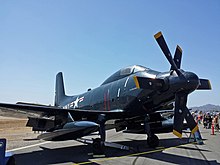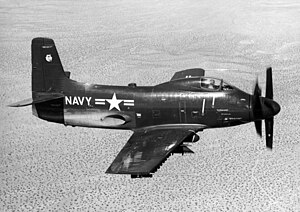|
Douglas A2D Skyshark
The Douglas A2D Skyshark was an American turboprop-powered attack aircraft built by the Douglas Aircraft Company for the United States Navy. The program was substantially delayed by engine reliability problems, and was canceled because more promising jet attack aircraft had entered development and the smaller escort carriers the A2D was intended to utilize were being phased out. Design and development On 25 June 1945, the Bureau of Aeronautics (BuAer) asked Douglas Aircraft for a turboprop-driven aircraft. Three proposals were put forth in the next year and a half: the D-557A, to use two General Electric TG-100s (T31s) in wing nacelles; the D-557B, the same engine, with contra-rotating propellers; and the D-557C, to use the Westinghouse 25D. These were canceled due to engine development difficulties, but BuAer continued to seek an answer to the high fuel-consumption of jet aircraft.[1] On 11 June 1947 Douglas received the Navy's letter of intent for a carrier-based turboprop. The need to operate from Casablanca-class escort carriers dictated the use of a turboprop instead of jet power.[2]  While it resembled the AD Skyraider, the A2D was different in a number of unseen ways. The 5,100-equivalent shaft horsepower (3,800 kW) Allison XT40-A2 engine had more than double the horsepower of the Skyraider's R-3350. The XT40 installation on the Skyshark used contra-rotating propellers to harness all the available power. Wing root thickness decreased from 17% to 12%, while both the height of the tail and its area grew.[3] Engine development problems delayed the first flight until 26 May 1950, made at Edwards Air Force Base by George Jansen.[3] Navy test pilot Cdr. Hugh Wood was killed attempting to land the first prototype XA2D-1, BuNo 122988, on 19 December 1950, on its 15th flight. He was unable to check the rate of descent, resulting in a high-impact crash on the runway.[4] The investigation found the starboard power section of the coupled Allison XT40A turboprop engine had failed and did not declutch. This meant the surviving engine was powering the failed engine's compressor, using up much of its available power. Additionally, the propellers failed to feather. As the wings' lift disappeared, a fatal sink rate was induced.[5] Additional instrumentation and an automatic decoupler was added to the second prototype, but by the time it was ready to fly on 3 April 1952, sixteen months had passed, and with all-jet designs being developed, the A2D program was essentially dead. Total flight time on the lost airframe was barely 20 hours.[5] Allison failed to deliver a "production" engine until 1953, and while testing an XA2D with that engine, test pilot C. G. "Doc" Livingston pulled out of a dive and was surprised by a loud noise and pitch up. His windscreen was covered with oil and the chase pilot told Livingston that the propellers were gone. The gearbox had failed, but Livingston successfully landed the airplane.[6] The A4D was ready to fly by the summer of 1954, but the escort carriers were being mothballed, so time had run out for the troubled A2D program.[7] Twelve Skysharks were built, two prototypes and ten pre-production aircraft. Most were scrapped or destroyed in accidents, and only one has survived.[8] Aircraft on display
Specifications (A2D-1) Data from Francillon 1988, pp. 441–443 General characteristics
Performance
Armament
See alsoRelated development Aircraft of comparable role, configuration, and era Related lists
Notes
BibliographyWikimedia Commons has media related to Douglas A2D Skyshark.
|
||||||||||||||||||||||||
